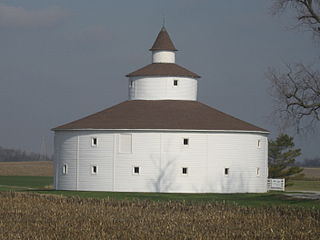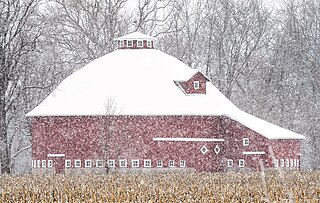
A round barn is a historic barn design that could be octagonal, polygonal, or circular in plan. Though round barns were not as popular as some other barn designs, their unique shape makes them noticeable. The years from 1880–1920 represent the height of round barn construction. Round barn construction in the United States can be divided into two overlapping eras. The first, the octagonal era, spanned from 1850–1900. The second, the true circular era, spanned from 1889–1936. The overlap meant that round barns of both types, polygonal and circular, were built during the latter part of the nineteenth century. Numerous round barns in the United States are listed on the National Register of Historic Places.

The Thomas Ranck Round Barn is a round barn in Waterloo Township near the Fayette-Wayne County, Indiana county line. It is one of many round barns built in Indiana during the late 19th and early 20th centuries. Of the round barns built in eastern Indiana during this period the Ranck Round Barn stands out as one of the most elaborately designed structures. The Thomas Ranck Round Barn was listed on the U.S. National Register of Historic Places in January 1983.

The W. H. York Round Barn, also known as Thompson Barn, is a historic round barn located on Country Road 249 (CR-249) a half mile south of Lodi, in Liberty Township, Parke County, Indiana. It was built about 1895, and is a two-level wood-frame structure on a brick foundation. The barn measures 56 feet in diameter. It has a conical roof topped by a circular cupola.

The Frank Senour Round Barn, also known as the Crandell Barn, is a round barn in the vicinity of Blackhawk, Vigo County, Indiana, about 13 miles south of Terre Haute.

The Utter-Gerig Round Barn is a round barn located in Henry Township near Akron, Fulton County, Indiana. It was built in 1915, and is a wood frame barn measuring approximately 63 feet in diameter. It rests on a fieldstone foundation and has two primary floors. The second level is reached by a broad earth ramp.

The Strauther Pleak Round Barn, also known as the "Pleak-Morgan Barn", is a round barn near Greensburg, Indiana, United States in Washington Township. Built in 1914, it was listed on the National Register of Historic Places in 1993. The barn is part of farmstead with a circa 1940 Indiana limestone ranch house, smoke house, spring house and garage. The main drive is looped enclosing a pen with a chicken coop and smaller barn.

The Cornish Griffin Round Barn, also known as the "Keeler Barn", is a historic round barn located near Pleasant Lake in Steuben Township, Steuben County, Indiana. It was built between 1910 and 1920, and is the only historic round barn in the state with glazed tiles, although many other barns in the state were built with unglazed tile silos. The two-level barn is topped by a two-pitch gambrel roof and the roof is sheathed in wood shingles.

The John Haimbaugh Round Barn in Newcastle Township near Rochester, Indiana, United States, is a round barn that was built in 1914. It was listed on the National Register of Historic Places in 1993.

The Kromberg Barn is a historic barn on East Pond Road in Smithfield, Maine. With an estimated construction date of the 1810s, it is one of the oldest barns in the area, and is architecturally rare as an example of a gambrel-roof barn built using older framing methods associated with traditional English barns. The barn was listed on the National Register of Historic Places in 2009.

The Clinton D. Gilson Farm is an outstanding example of a vernacular constructed farmstead for the late 19th century. The farm consists of outbuildings, the English barn, brooder houses, and a machine shop. The farm is located 3.5 miles (5.6 km) northeast of Hebron, Indiana. The Clinton D. Gilson Barn was built in 1892 and is on the National Register of Historic Places. It is the dominant structure on the Gilson Farm. A windmill was once located on the west end of the barn and an elevator on the east end.

Ben Colter Polygonal Barn, also known as the Reinhart Barn, is a historic hexagonal barn located at St. Marys Township, Adams County, Indiana. It was built about 1907, and is a six-sided, two-story, frame barn with a cone roof and cupola. Attached to the barn is a drive-through shed.

The Marion Ridgeway Polygonal Barn located in LaPorte County on the southern edge of LaPorte, Indiana, is a multi-sided barn. Built in 1878 by Marion Ridgeway and called the Door Prairie Barn. The barn sits east of highway 35 surrounded by woods and cultivated fields. The nine-sided barn is south of a rectangular barn. The barn has nine sides and is two stories tall. The roof is capped with a sectional cone roof with a nine-sided cupola in the Gothic Revival/Italianate style. Within the louvered panels trim pieces resemble a lancet arch. The post and beam frame sits on wooden sill propped on stone.

The Menno Yoder barn is one of the two remaining poured concrete polygonal barns in the United States state of Indiana. Built on the outskirts of Shipshewana in 1908 by Menno Yoder, this twelve-sided barn has been expanded upon. It is known as the Brown Swiss Dairy barn. A gravel drive extends to the barn, passing the 1911 concrete farmhouse. The polygonal barn consists of the original 1908 twelve-sided barn, a 1911 attached silo, a c.1920 rectangular addition, and a 1960s one story addition. Next to the barn is a free standing c.1950 milk house.

Maria and Franklin Wiltrout Polygonal Barn, also known as the Alfred Barn, is a historic 14-sided barn located in Fairfield Township, DeKalb County, Indiana. The house was built in 1910, and is a two-story, wood-frame structure measuring 60 feet in width. It is topped by a two-pitch gambrel type roof with a 14-sided cupola. It is one of three 14-sided barns left in Indiana.

Robert Orr Polygonal Barn, also known as the Oxenrider Barn, is a historic twelve-sided barn located in Plain Township, Kosciusko County, Indiana. It was built between 1909 and 1911, and is a two-story, twelve-sided frame barn. It is topped by a three-pitch gambrel roof and a twelve-sided cupola.

Ramsay–Fox Round Barn and Farm is a historic round barn and farm in West Township, Marshall County, Indiana. The farmstead was established about 1900. The round barn was built about 1911 and is a true-circular barn, with a 60-foot (18 m) diameter. It has a two-pitch gambrel roof topped by a cupola and consists of a main level and basement. Also contributing are the farm site, farmhouse, milk house, windmill, and privy.

William Fisher Polygonal Barn, also known as the Fisher-Dykes Barn, is a historic 10-sided barn located in Sugar Creek Township, Montgomery County, Indiana. It was built in 1914, and is a two-story, balloon frame structure on a concrete foundation. Two of the 10 sides are 28 feet wide, while the 8 remaining sides are 16 feet wide. The barn is topped by a sectional two-pitched gambrel roof with flared eaves. Atop the roof is a six-sided cupola.

William Hill Polygonal Barn, also known as the Hill-Mershon Barn, is an eight-sided barn located at Bloomingdale, Parke County, Indiana. It was built about 1905, and is a two-story, octagonal frame building. It measures 30 feet in width and is topped by a sectional cone roof topped by an octagonal cupola.

George Rudicel Polygonal Barn is a historic 12-sided barn located in Noble Township, Shelby County, Indiana, USA. It was built in 1910 and is a two-story, vernacular frame barn. It is topped by a cone roof with a large dormer and square cupola.

S.C. Snider and George McFeeley Polygonal Barn, also known as the Shearer Barn, was a historic round barn located near Huntington in Huntington County, Indiana. It was built in 1906, and was a 12-sided, two-story frame barn. It had a sectional, three pitched gambrel roof topped by a cupola. It has been demolished.


























